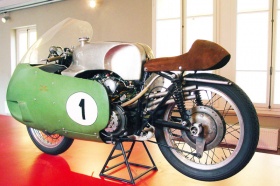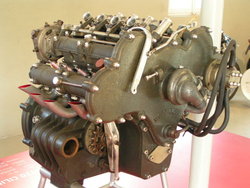Moto Guzzi Grand Prix 500 cc V8

| |
| Moto Guzzi Grand Prix 500 cc V8 | |
|---|---|
| Aka | The Otto, Ottocilindri |
| Manufacturer | Moto Guzzi |
| Model year | 1955–1957 |
| Class | Grand Prix racing motorcycle |
| Engine | 499 cc (30.5 cu in) (44 x 41 mm) 4-stroke V8 liquid cooled, DOHC, 8 Dell'Orto 20 mm carburetors |
| Top speed | 275 km/h (171 mph |
| Power | 78 hp (58 kW) at 12000 rpm |
| Transmission | choice of 4, 5 or 6 gears |
| Brakes | drum |
| Tires | Front: 2.75" x 19" Rear: 3.00" x 20 |
| Dry weight | 148 kg (326 lb) (dry) |
The Moto Guzzi V8 (aka 'Otto') motorcycle was designed by Giulio Cesare Carcano specifically for the Moto Guzzi racing team for the 1955 to 1957 seasons. Though following the two stroke Galbusera V8 of 1938, the Moto Guzzi Otto motorcycle and its engine represent a unique and historically significant engineering milestone.
The Discovery Channel ranked the Guzzi Otto as one of the top ten greatest motorbikes of all time.
History
By 1955, Moto Guzzi had already demonstrated its engineering prowess, creating motorcycles with a wide breadth of configurations: horizontal singles, parallel twins, V-twins in in-line and transverse layouts, 3-cylinders, and 4-cylinders in horizontal and in-line form. Ultimately The Moto Guzzi V8 (The Otto Cylindri) reinforced Guzzi's commitment to pushing engineering boundaries. The engine was conceived by Giulio Carcano, Enrico Cantoni, Umberto Todero, Ken Kavanagh and Fergus Anderson just after the 1954 Monza Grand Prix and designed by Dr. Carcano.
To introduce the bike, and build publicity, Moto Guzzi's racing team manager, Fergus Anderson, released a letter to the international motorcycle press announcing Guzzi's plans for the 1955 Grand Prix season -- attaching a drawing of the new Otto and challenging the to guess the configuration of Guzzi's then very secret racing bike. Very few guessed correctly, and the Otto made a stunning public debut a few months later.
The engine and the bike were without precedent: a water cooled, 500 cc V-8 motorcycle -- with dual overhead cams and a separate carburetor for each of the eight cylinders. Weighing only 45 kg (overall bike weight 148 kg, 326 lb), it's miniaturized components tightly packaged, the engine produced an unprecedented 72hp at 12,000 rpm. The motorcycle proved capable of achieving 172 mph (280 km/h) -- 20 years before the speed was reached again in Grand Prix motorcycle racing.
Tire, brake and suspension technology, however, lagged behind the powerful engine -- making race course field testing difficult and and actual racing dangerous. Fergus Anderson crashed the motorcycle on its maiden run in Modena. Ultimately, only Fergus Anderson, Stanley Woods, Dickie Dale, Ken Kavanagh, Keith Campbell, Guiseppe Colnago and Bill Lomas were ever able to even ride the V8 motorcycle. Several of the riders experienced spectacular falls -- Bill Lomas suffering a head injury at the 1956 Senigallia Gran Prix. Ken Kavanah refused to ride the motorcycle after the 1956 race at Spa-Francorchamps.
The Otto Cylindri also proved complex and expensive to build and maintain -- bikes suffered broken crankshafts, overheating, seizing -- all in addition to the danger the bike posed to the racers themselves. By 1957 there were two bikes available and no one willing to race the bike -- without further development. In the end, The Otto remained undeveloped, as Moto Guzzi and other manufacturers withdrew from racing entirely in the 1957 season. Speculation suggests that with further development, the V8 could have proved a formidable Grand Prix contender.
Two authentic examples of the engine remain in the possession of the Moto Guzzi, at the Mandello museum.
Specifications
- Engine: 4 stroke V8
- Cylinders: 8
- Cooling: liquid cooled
- Camshaft: 2 DOHC
- Capacity: 499 cc (44 x 41 mm)
- Power output: 78 hp at 12000 rpm
- Carburettors: 8 Dell'Orto 20 mm carburettors
- Gearbox: choice of 4, 5 or 6 gears
- Brakes: drum
- Front tyre: 2.75" x 19"
- Back tyre 3.00" x 20"
- Weight: 148 kg
- Maximum speed: 275 km/h
